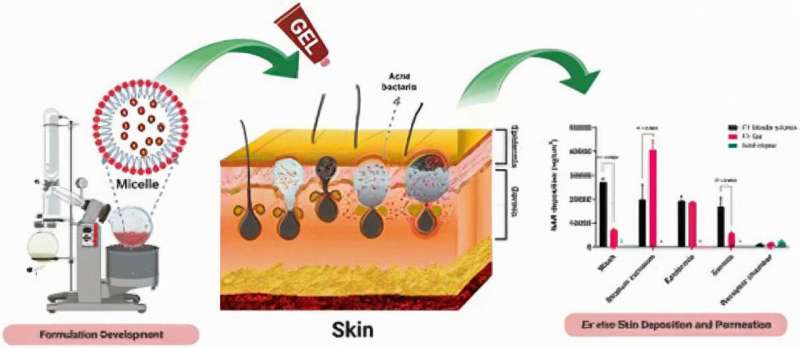
It’s a skin disorder that makes life miserable for around 800 million teenagers and adults worldwide, but Australian scientists may have found an effective treatment for acne, delivered via tiny nanoparticles.
In a study led by the University of South Australia (UniSA), a new antibacterial compound known as Narasin was encased in tiny, soft nanoparticles 1,000 times smaller than a single strand of human hair and applied in a gel form to targeted acne sites.
The drug—more commonly used in the livestock industry—proved successful against drug-resistant acne bacteria and delivered via nanocarriers achieved a 100-fold increase in absorption than simply taken with water.
The findings have been published in the journal Nanoscale.
Lead author UniSA Ph.D. student Fatima Abid says this is the first time that nano-micelle formulations of Narasin have been developed and trialed.
“Acne severely impacts approximately 9.4% of the world’s population, mainly adolescents, and causes distress, embarrassment, anxiety, low self-confidence and social isolation among sufferers,” Abid says.
“Although there are many oral medications prescribed for acne, they have a range of detrimental side effects, and many are poorly water soluble, which is why most patients and clinicians prefer topical treatments.”
Abid’s supervisor, pharmaceutical scientist Professor Sanjay Garg, says a combination of increasing antibiotic resistance and the ineffectiveness of many topical drugs to penetrate hair follicles in acne sites means there is a pressing need to develop new antibacterial therapies that are effective and safe.
Narasin is commonly used for bacterial infections in livestock but has never been previously investigated as a viable treatment for acne.
Abid, Prof. Garg and researchers from UniSA, the University of Adelaide, and Aix-Marseille Université in France also investigated how well Narasin encased in nanoparticles penetrated various layers of skin, using pig’s ear skin as a model.
“The micelle formulation was effective in delivering Narasin to acne targets sites, as opposed to the compound solution which failed to permeate through skin layers,” Prof. Garg says.
More information:
Fatima Abid et al, Nanotechnology and narasin: a powerful combination against acne, Nanoscale (2023). DOI: 10.1039/D3NR01789C
Journal information:Nanoscale
Provided by
University of South Australia

READ MORE
How Aphrodisiacs Work
Nanotubes as optical stopwatch for the detection of neurotransmitters
The researchers visualize neurotransmitters with the help of carbon nanotubes. Credit: RUB, Kramer Carbon nanotubes [...]
Giant African Land Snails Invade South Florida Again
Giant African land snails like these have been spotted again in South Florida. The invasive [...]
10 Ideas for a Green Transportation Infrastructure
There are ways to green our transportation infrastructure and simultaneously improve our health and quality [...]
Monolayer hexagonal boron nitride can extend plasmonic enhancement limit
(Left) Schematic of a monolayer h-BN as hot-electron tunneling barrier. (Right) Change of volume-averaged SERS [...]
Shark Skin-Inspired Materials Have a Long Way to Go Before They Work Like the Real Thing
Shark skin is made of tiny, stiff segments of overlapping, textured dentin and enamel. Shark [...]
Achieving higher performance with potassium ion battery
Three different typical MXene electrodes, i.e., Nb2C, Ti2C and Ti3C2, are investigated upon their electrochemical [...]
Efficient and durable water splitting in acidic media
(a) Valence band photoemission spectra of Au@AuxIr1-x and standard samples. The white bar represents the [...]